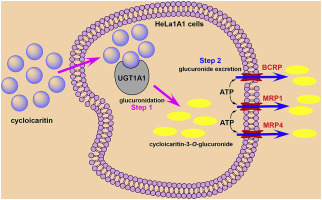Chemico-Biological Interactions ( IF 5.1 ) Pub Date : 2018-09-17 , DOI: 10.1016/j.cbi.2018.09.001 Shishi Li , Jinjin Xu , Zhihong Yao , Liufang Hu , Zifei Qin , Hao Gao , Kristopher W. Krausz , Frank J. Gonzalez , Xinsheng Yao

|
Cycloicaritin is a bioactive natural phenolic compound from Epimedium species. However, the glucuronidation and excretion which would influence oral bioavailability and pharmacokinetics of cycloicaritin still remain unknown. Here we aimed to establish UGT1A1 stably transfected HeLa cells, and to determine the contributions of BCRP and MRPs transporters to excretion of cycloicaritin-3-O-glucuronide. First, β-estradiol was used to validate the expression of active UGT1A1 protein in engineered HeLa1A1 cells. Furthermore, Ko143 (5 and 20 μM) led to a significant decrease (42.4%–63.8%, p < 0.01) in CICT-3-G excretion and obvious accumulation (19.7%–54.2%, p < 0.05) of intracellular CICT-3-G, while MK571 (5 and 20 μM) caused a significant reduction (46.8%–64.8%, p < 0.05) in the excretion and obvious elevation (50.7%–85.2%, p < 0.01) of intracellular level of CICT-3-G. Furthermore, BCRP knocked-down brought marked reduction in excretion rates of CICT-3-G (26.0%–42.2%, p < 0.01), whereas MRP1 and MRP4-mediated silencing led to significant decrease in the excretion of CICT-3-G (23.8%–35.4%, p < 0.05 for MRP1 and 11.9%–16.0%, p < 0.05 for MRP4). By contrast, neither CICT-3-G excretion nor CICT-3-G accumulation altered in MRP3 knocked-down cells as compared to scramble cells. Taken together, BCRP, MRP1 and MRP4 were identified as the most important contributors for CICT-3-G excretion. Meanwhile, the UGT1A1 modified HeLa cells were a simple and practical tool to study UGT1A1-mediated glucuronidation and to characterize BCRP and MRPs-mediated glucuronide transport at a cellular level.
中文翻译:

乳腺癌抗性蛋白(BCRP / ABCG2)和多药抗性相关蛋白(MRPs / ABCCs)在过表达UGT1A1的HeLa细胞中环环素-3- O-葡糖酐排泄中的作用
环木素是一种来自淫羊species属物种的生物活性天然酚类化合物。然而,仍会未知会影响口服环磷酰胺的生物利用度和药代动力学的葡萄糖醛酸化和排泄。在这里,我们旨在建立UGT1A1稳定转染的HeLa细胞,并确定BCRP和MRPs转运蛋白对cycloicaritin-3- O-葡萄糖醛酸排泄的贡献。首先,β-雌二醇用于验证工程化HeLa1A1细胞中活性UGT1A1蛋白的表达。此外,Ko143(5和20μM)导致 CICT-3-G排泄显着下降(42.4%–63.8%,p <0.01)和明显的积累(19.7%–54.2%,p <0.05)的细胞内CICT-3-G,而MK571(5和20μM)导致排泄物显着减少(46.8%–64.8%,p <0.05),并明显升高(50.7%–85.2%,p <0.01) )的细胞内CICT-3-G水平。此外,敲除BCRP可使CICT-3-G的排泄率显着降低(26.0%–42.2%,p <0.01),而MRP1和MRP4介导的沉默导致CICT-3-G的排泄显着减少。 ( 对于MRP1,分别为23.8%–35.4%,p <0.05和11.9%–16.0%,p 对于MRP4,<0.05)。相比之下,与加扰细胞相比,在MRP3敲除的细胞中CICT-3-G的排泄和CICT-3-G的积累都没有改变。总体而言,BCRP,MRP1和MRP4被确定为CICT-3-G排泄的最重要贡献者。同时,UGT1A1修饰的HeLa细胞是研究UGT1A1介导的葡糖醛酸糖化并在细胞水平表征BCRP和MRPs介导的葡糖醛酸苷转运的简单实用工具。


























 京公网安备 11010802027423号
京公网安备 11010802027423号